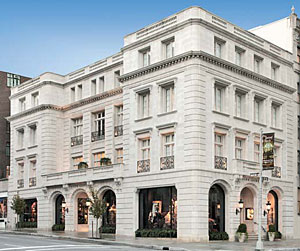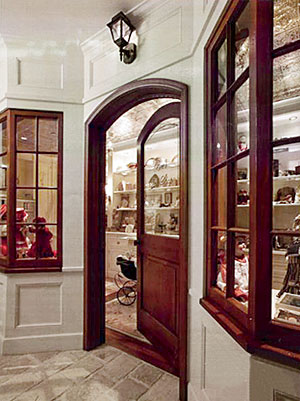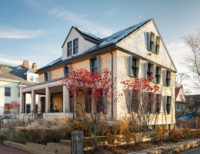Retro-American fantasies furnished by Ralph and Barbra.
America — land of the free and home of self-actualization — remains unsurpassed for the license we grant to wholesale personal reinvention, a transformative process perhaps most tellingly revealed in people’s homes. Our ingrained national penchant for imagining whom you want to be and then becoming it grew to unprecedented proportions during the Golden Age of Hollywood.


Those who came to cultural awareness during the heyday of the great motion picture studios have been particularly susceptible to the spell cast by the silver screen, a magical aura that suffused not only manners and mores, but also dress and design. This demographic includes Ralph Lauren (b. 1939), Barbra Streisand (b. 1942), and Robert A.M. Stern (b. 1939) — whom architecture critic Paul Goldberger has lauded as “the Ralph Lauren of American architecture.” As creators and protagonists of their own time-warping myths, they have few present-day equals.
Small wonder that these three near-contemporary products of Brooklyn and the Bronx are leading exponents of deeply nostalgic, unapologetically romantic, and blissfully bogus evocations of tradition and class as purveyed by Louis B. Mayer, Jack Warner, Samuel Goldwyn, and their movie-mogul ilk. How else to explain the giddy theatricality, freewheeling excess, and sheer obliviousness to the here and now that took center stage when, in remarkably similar ways (save for one striking divergence), Lauren and Streisand lately realized mirror-image visions of the American dream house circa 1940?
For nearly four decades Lauren has been steadily perfecting his directorial approach to design in an ever-widening series of manifestations from men’s clothing to women’s fashions to home furnishings. Goldberger has called Lauren (with no apparent irony) ”a one-man Bauhaus.” This mega-merchant’s ever more comprehensive story line now encompasses architecture on the civic scale, as demonstrated by the recent opening of his latest retail extravaganza — a big, new, old-fashioned building on Manhattan’s Upper East Side.
Michael Gilmore (of the Scottsdale, Arizona firm Weddle Gilmore Architects), with executive architect Thomas Hut (Hs2 Architecture), designed the grandiose store at 72nd Street and Madison Avenue. It faces the Polo Ralph Lauren flagship in the former Rhinelander Mansion, a French Renaissance Revival pile by Kimball & Thompson, which was completed in 1898 and internally revamped by interior designer Naomi Leff for Lauren in 1986.
As Departures magazine recently burbled, “[E]verything from the Beaux Arts–inspired facade to the richly ornamented interior looks and feels like an 1880s building or, even better, as if it were the Gilded Age all over again.” Indeed, this is a pluperfect specimen of the heartless hedge-fund luxe that typifies what has been called America’s Second Gilded Age.
It must be admitted that the architects’ French-inspired wannabe mansion is technically well executed — for this kind of thing, as the expression goes. But in a quite different way from Leff’s Anglomaniacal Polo Ralph Lauren clubhouse across Madison Avenue, this new building approximates a private residence only if you happen to inhabit a maison particulier in Paris. Alternatively, one thinks of those “Fifth Avenue” mansions portrayed in 1930s screwball comedies, which looked no more like the real thing than this concoction. The Home department, on the uppermost story, is decorated in Lauren’s three favorite interior design styles — Old English, Moderne, and Safari — but it all seems as inauthentic as Meryl Streep’s and Robert Redford’s accents in Out of Africa.
In contrast, Streisand’s Malibu home — subject of her jaw-dropping new monograph, My Passion for Design (Viking) — aims to be as American as Kansas corn in August. However, the incongruous complex she has built on a bluff overlooking the Pacific — a cluster of fake barns, sham silos, and clapboard cottages crammed together like a miniature golf course — brings to mind Richard Mique’s Hameau de la Reine of 1775–1784 at Versailles, the faux-rustic farm hamlet where Marie Antoinette played at being a milkmaid while peasants starved. It’s not just the artificial pond, stream, and operative waterwheel that the two twee ensembles have in common, but rather the same disquieting feeling they provoke — that ostentatious simplicity is the ultimate decadence.
Streisand, by her own detailed admission, is the client from hell. She relates how she hired and fired one hapless (and nameless) architect after another before resorting to movie-set designers who executed things to her control-freak liking. Most bizarre of her specifications is what she calls the “street of shops” in her basement — a cobblestone-paved walkway flanked by phony, glass-fronted emporiums in which she displays her various collections, each named accordingly: Bee’s Doll Shop, the Antique Clothes Shop, the Gift Shoppe, etc. Ralph would never do this.
The owner claims she got the idea from a similar exhibit at the Winterthur Museum, but a more likely source was the famous Street of Shops devised for New York’s Henri Bendel by its legendary president, Geraldine Stutz, in 1958. So now we have Ralph Lauren endeavoring to make his store seem like a house and Barbra Streisand laboring to make her home look like a series of salesrooms: a dizzying Through the Looking-Glass inversion emblematic of our society’s dual addictions to celebrity and consumption.






Post a comment to this article
Report Abusive Comment